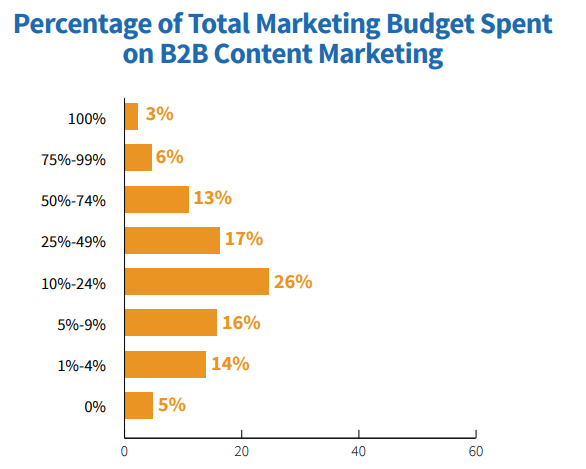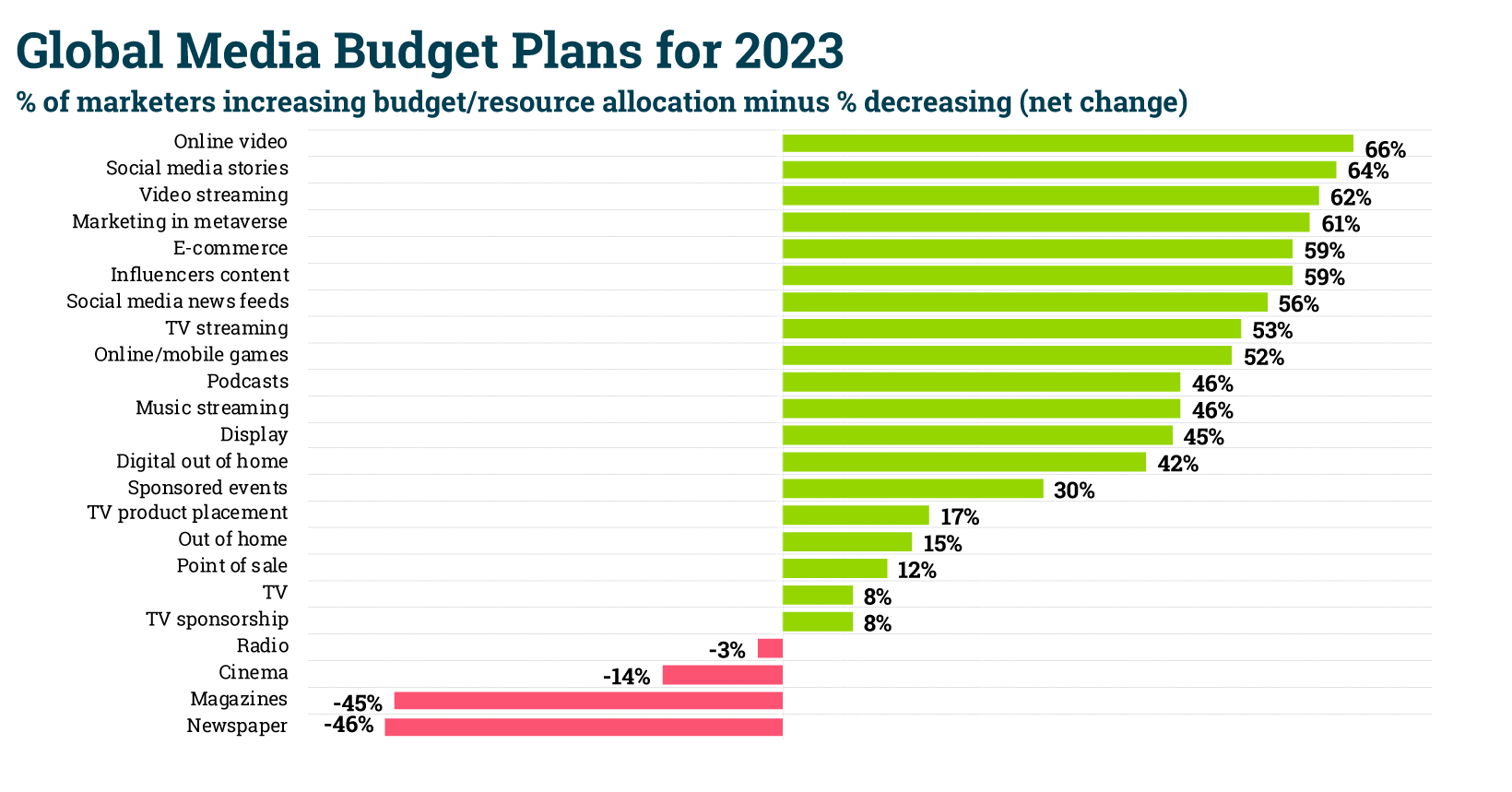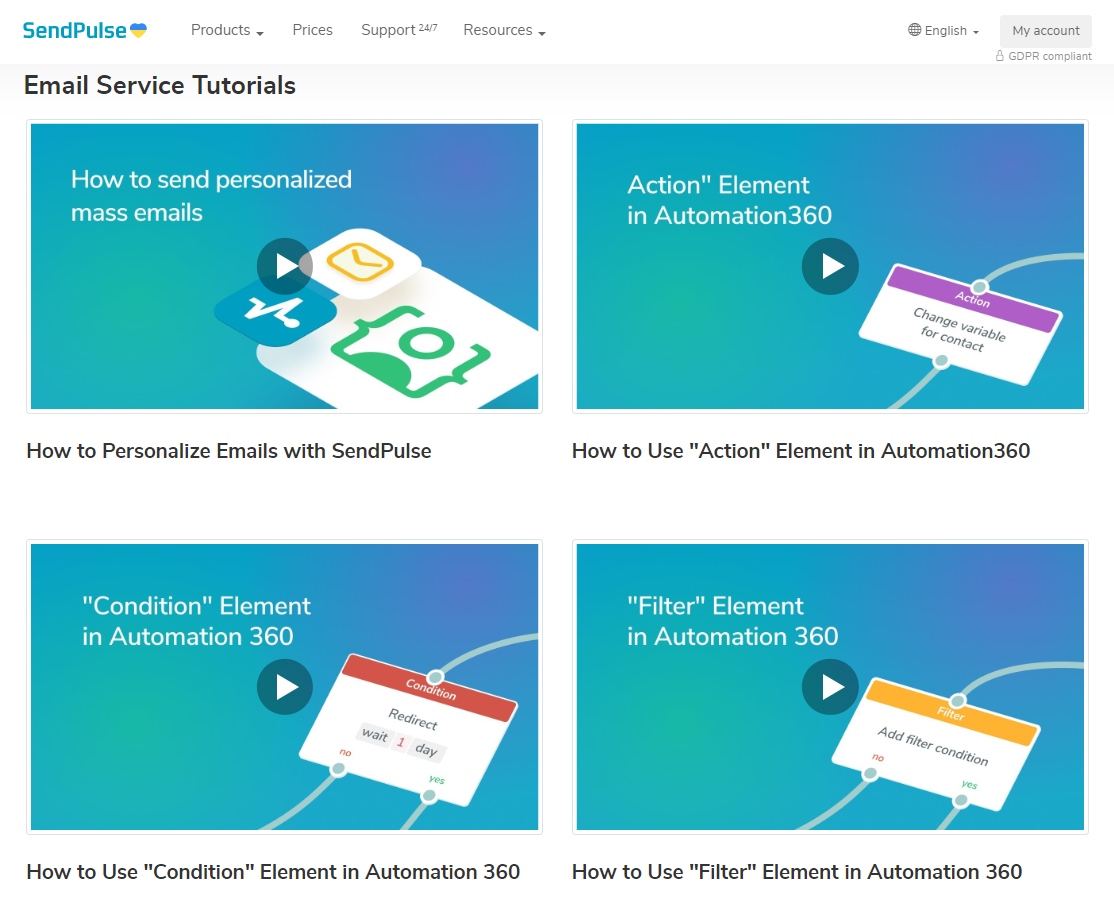When you’re budgeting, it can easily feel like every business process wants a slice of the pie. We’re going to walk you through the process of figuring out how much of your budget to allocate to content marketing in 2023, as well as the reasons behind our advice.
Content:
The average content budget per industry
Of course, the amount you should be putting towards your content marketing budget will vary depending on several key factors. Those include the relative size of your company, the industry you work within, and, crucially, the total budget you’ve got available.
Rather than looking at fixed values that you should be spending depending on your industry, it’s often more beneficial to ensure your content budget takes up a fixed percentage of your overall marketing budget.
For example, research shows that 43% of marketers spend between 10% and 50% of their budget on content marketing. So, if you’re putting around one-fourth of your marketing funds towards content, you’re likely to be keeping up with other leaders in your industry.

Factors to consider when making a content marketing budget
It’s important to bear in mind that you’re never creating budgets in a vacuum. Instead, various factors impact and influence the budget you’re putting together; we’ve curated a list of the most significant ones to take into account.
Company revenue
Not all businesses are equal in this regard, and that matters.
Companies with high levels of revenue will typically have more room in their budget. If your business falls into that category, it makes sense to take up more of that room for content marketing, as this will allow you to keep growing your business and bottom line.
On the other hand, companies with lower or less desirable revenue levels don’t have as much wiggle room. This means they’ll need to allocate less money to each item in their budget, at least until they’re able to boost their bottom line.
Strategy shift amidst inflation and recession
Going into 2023, we can’t expect last year’s problems, including inflation and economic recession, to vanish. Instead, we’ve got to account for them in our planning.
Inflation leads to price increases across the board as each individual dollar’s worth is reduced. This means that last year’s budgets can’t be reused without double-checking every aspect of them because this year’s climate has shifted.
Recessions have similar consequences. Additionally, recessions affect the things that customers are willing or able to spend money on — so expecting consumers to behave as they would without the pressures that come with a recession is not appropriate.
The type of content you need
The term “content marketing” is a little misleading; not all content is the same, after all. You wouldn’t allocate the same budget to creating a 5-minute video as you would give a blog entry that takes 5 minutes to read.
Content marketing emphasizes the importance of creating value for your customers throughout all of your content. That means giving careful thought to the types of content you’re looking to create. Below are some of the most popular forms.

Blogs
Text-based blog posts can usually be put together by one person or a small team. This means they tend to be less costly to include in your budget than some of the other items on this list.
Of course, the frequency you’re looking to put out blog posts affects their cost too. That frequency, in turn, is affected by the length of the posts, the level of detail they go into, the amount of research they require, and other factors.
Blogs are often the first place customers searching for information will find themselves. They represent a space where you can educate and entertain your audience, all without real-time interactions, ensuring you can passively connect with leads and customers.
Video content
This is a more expensive but also very popular type of content.
Videos can vary in length, subject, and intended upload place. For example, a video created for a business’s TikTok would not look the same as one made for your company’s homepage. Each type of video comes with its own costs and requirements.
Since they convey information audiovisually, they help you capture viewers’ attention. They’re also great for getting points across in limited time frames.
For example, SaaS companies can share short video tutorials with their customers. They get all the important information across and provide easily accessible resources for viewers.

Media assets
Perhaps what you need most is media assets, which exist in various forms as well. You might, for example, want to make a company podcast that talks about current affairs and how they affect your business. You could also create how-to guides for tasks that are relevant to your audience, such as instructions for how to use a product or deal with upcoming legislative changes.
Sage, for example, identified that HMRC’s new scheme for tax digitalization could present a challenge for their clients. So, they produced a free downloadable guide on how to make tax digital alongside podcast episodes on the same topic.
More isn’t always better here. In fact, it will serve your company best in most cases to ensure that your assets are of the highest quality instead of having as many of them as possible.

Content promotion
Unless every member of your target demographics is already incredibly engaged with your company, content will rarely promote itself without your direct input.
This is why you’ve got to make room in the budget for content promotion and promotional content.
Great content promotion leads to an increase in the number of leads you generate. That, in turn, means boosting your overall revenue, so you’ve got more resources to put toward content marketing in the future.
Influencers and sponsored content
As we’ve just mentioned, promotion is key, and influencers are hugely helpful in this regard. Likewise, sponsored content can help you reach more people across platforms, ensuring you can connect with more potential leads while building your brand’s reputation.
While influencers and sponsored content aren’t sourced from within your company in most cases, it’s important to give them space in your budget. This helps you create healthy, productive working relationships with the creators you choose, so you can mutually benefit one another.
For example, fitness and wellness brand Alo Moves partnered with influencer Grace Bae to promote their content on Instagram.

How to set up a marketing budget for 2023
Next, we’ll take you through the practical tasks involved in establishing a marketing budget to take you through 2023.
Determine your marketing goals
Creating the perfect plan is difficult when you don’t know your goals inside and out—and marketing budget plans are no exception.
Before suggesting figures, you’ve got to know exactly what you want to achieve and where you want to direct your focus. Are you prioritizing lead generation, customer engagement, both, or something else? Are you focusing on emotional marketing or another tactic?
Whatever your goals, they need to influence everything about your budget. Also, your budget needs to specifically account for items that will help you achieve those goals.
Estimate campaign costs
You need to know what you’re working with, and you’ll rarely have exact figures from the get-go. Unless there are no unpredictable factors, you’ll want to rely on fact-based, research-backed estimates for your campaign costs.
As a tip, it’s always better to overestimate costs than to lowball them. This is because there’s nothing wrong with discovering you have extra money left over that you’d planned to use. However, realizing you didn’t leave enough room for any eventualities can be disastrous.
Create a budget template to follow
Creating budgets from nothing can be challenging. It’s also often unproductive, requiring you to adjust and fine-tune every last feature of the budget as you go.
To avoid this situation, it’s better to put together a budget template that you can return to at any point.
This template acts as your guide. It tells you what information you need, where to plug numbers in, and more while making sure the final product looks neat and clean. In other words, templates should help you create better budgets in less time.
Choose a budgeting and accounting software
When it comes to accounting, there are a few different options available, and it’s important that you choose a tool that’s specifically suited to your business.
Firstly, you could hire an accountant. As these are knowledgeable professionals, accountants are a great choice for anyone new to budgeting or business in general. However, a single accountant might not be appropriate for a large corporation.
Another option is to hire a firm instead, which is more common for large companies. Firms comprise plenty of experts, each with their own niche knowledge so that you can cover all your bases.
Bigger enterprises may also use in-house teams. The major benefit here is that there are no extra logistics involved in working with them, as they’re already part of your company. However, small businesses, startups, and freelancers in particular don’t tend to have the resources for this.
Instead, freelancers will want dedicated tools that help them do the bulk of their accounting on their own. This is where a solution like Sage self-employed accounting software shines, as it doesn’t rely on hiring outside help or using teams you don’t have access to.
Conclusion
We can’t give you a precise-to-the-penny figure that tells you exactly how much to allocate to your content marketing budget without getting to know your company first. What we can do is give you the tools you need to work that number out for yourself.
While the “25-30%” allocation we referenced above serves as a helpful general guideline, it’s affected by plenty of other factors. Only by taking everything we’ve mentioned into consideration, then putting it into practice can you find the ideal budget for your content marketing efforts.








